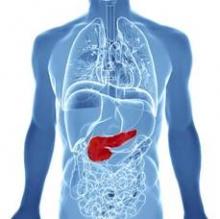Cytology and a microRNA-based test identified pancreatic cancer 91% of the time in specimens obtained by endoscopic ultrasound-guided fine-needle aspiration – a substantial improvement, compared with cytology alone, researchers reported in the October issue of Clinical Gastroenterology and Hepatology.
The microRNA-based test could help reduce repeated fine-needle aspirations (FNAs) due to indeterminate cytologies, said Dr. Randall Brand of the University of Pittsburgh Medical Center and his associates. Correctly assessing pancreatic cancer before surgery also could help patients start neoadjuvant therapy sooner if appropriate, they noted.
Several microRNAs are expressed abnormally in patients with pancreatic ductal adenocarcinoma. The new test contains five of these sequences and is the first of its type for pancreatic cancer, the researchers said. To evaluate the assay, they assessed and compared relative quantitative polymerase chain reaction and cytology results from 95 formalin-fixed paraffin-embedded specimens and 228 endoscopic ultrasound-guided FNAs. Specimens were collected during routine visits by patients with solid pancreatic masses, the investigators said (Clin. Gastroenterol. Hepatol. 2014 October [doi:10.1016/j.cgh.2014.02.038]).
The test used together with cytology correctly identified pancreatic cancer in 91% of positive specimens (95% confidence interval, 85.6%-94.5%), while cytology alone had a sensitivity of 79% (95% CI, 72.2%-84.5%), the researchers reported. Cytology and the microRNA test each had positive predictive values greater than 99% (95% CI, 96%-100%), they added.
When used alone, the microRNA test had a diagnostic sensitivity of more than 82% and a specificity of 96% – better than cytology on the same specimens, the investigators said. And the test correctly found pancreatic cancer in 22 of 39 specimens previously assessed as benign, indeterminate, or nondiagnostic by cytology, they said.
The researchers separately assessed 46 specimens collected percutaneously instead of by endoscopic ultrasound-guided FNA and found much lower (58%) diagnostic sensitivity and a higher rate of technical failures, although specificity and predictive value still approached 90%, said the investigators. The percutaneous specimens all were collected from two study sites outside the United States, so further studies would need to validate whether a percutaneous approach could replace endoscopic ultrasound-guided FNA, they said.
Cytology and microRNA testing also had to be performed on different FNA specimens, a limitation that "could have contributed to some of the observed discrepancies between cytology and molecular results," the investigators said.
Pancreatic cancer remains notoriously difficult to treat, with overall 5-year survival rates of only about 6%. MicroRNA sequences are stable and can reliably be recovered from both formalin-fixed and FNA specimens, making them a "particularly promising" class of biomarkers for pancreatic and other cancers, the researchers said. Based on the study results, future studies should explore the test’s prognostic potential, such as for distinguishing patients with resectable tumors that are likely to progress early or to guide choice of therapies, they said.
The study was supported by Asuragen and by a grant from the German Federal Ministry of Education and Research. Dr. Brand and another author reported that they are on the clinical advisory board of Asuragen, and six of 27 coauthors reported being employees of the company. The rest reported no conflicts of interest.


